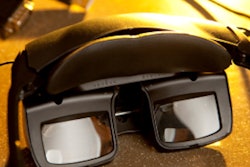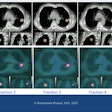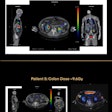
It's a brave new world when it comes to virtual reality (VR) technology -- and there are exciting ways to harness VR to improve patient care in radiation therapy, according to research shared October 26 at the American Society for Radiation Oncology (ASTRO) 2021 annual meeting in Chicago.
A wide range of researchers, from medical students to nurse practitioners to physicians, delivered results from studies that explored using virtual reality for a variety of uses, from improving patients' understanding of their cancer to offering virtual follow-up for prostate cancer patients.
"[This research addresses] patients' awareness and understanding of radiation oncology as a whole and [confronts] taboos against radiation therapy," said conference moderator Dr. Laura Dawson of the University of Toronto in Canada.
Imaging VR boosts patients' understanding
The first ASTRO presentation shared results from research that showed how using a virtual reality volumetric imaging review helped cancer patients not only better understand the nature and scope of their disease but also the reason for their treatment. Dr. Douglas Holt of Eastern Idaho Regional Medical Center in Idaho Falls and colleagues conducted a study that included 38 cancer patients and their caregivers who viewed 2D images of the patients' disease on a computer screen. Patients were then shown a 3D virtual reality volumetric review of imaging and intended radiation treatment targets.
 Dr. Douglas Holt.
Dr. Douglas Holt.After the VR review, patient and caregiver understanding of the cancer increased dramatically, from a ranking of 5.6 out of 10 to 9.2, the group found. The VR review also improved understanding of the treatment rationale -- increasing it from a ranking of 2 to 2.9 (on a scale of 0 to 3, with 0 being no understanding and 3 being full understanding).
As well, 97% of study participants stated that "VR should be standard of care," Holt noted in his presentation.
"[One of the patients told us that VR] 'was more helpful than my doctors just trying to explain [treatment],' " he said.
Prostate cancer follow-up goes virtual
In a second presentation, Richard Boyajian, a nurse practitioner at Dana-Farber/Brigham and Women's Cancer Center in Boston, shared results from a study that explored the efficacy of a virtual clinic for monitoring prostate cancer patients and evaluated its clinical and financial impact and patient satisfaction.
The virtual clinic was established in 2015 and staffed by nurse practitioners who followed up with men who had completed prostate cancer treatment; the nurses and the patients interacted by telephone, email, or messaging using an electronic health portal. Follow-up consisted of a prostate-specific antigen (PSA) test at an affiliated lab -- with those results reported to the cancer center -- and questionnaires the patients submitted electronically. The digital platform on which the virtual clinic was based categorized PSA results as indicative of relapse or no relapse, and those men with evidence of cancer recurrence were called in for further imaging.
The study included 1,397 patients enrolled in the virtual clinic, and its time frame was between March 2016 and July 2020. Boyajian's team found that 94.3% of patients were comfortable with being monitored in this way, and the majority stated that the virtual clinic saved them time (92.4%) and reduced out-of-pocket expenses (87.3%).
The investigators also found that although visits to the virtual clinic were not reimbursed, it appeared to free physicians to care for new patients and thus increased genitourinary radiation oncology revenue growth each year (26.6% in 2016, 43.3% in 2017, 40.3% in 2018, and 74.4% in 2019).
"[The virtual prostate cancer clinic] allows a small number of providers to manage a larger patient population, while still ensuring the entire population receives the care they need," Boyajian said.
Cool vids reduce need for pediatric anesthesia
Children undergoing radiation therapy often need to be anesthetized so that they won't move during the procedure. But a group of University of Texas Southwestern Medical Center researchers found that letting kids watch a video they choose themselves during the treatment can effectively curb the squirm.
Jeffrey Chapman and colleagues developed the Pediatric Radiation Oncology with Movie Induced Sedation Effect (PROMISE), a wireless video streaming tool that not only allows children to pick out a movie to watch during treatment but also turns off both the radiation beam and the show if the child moves beyond a particular parameter. The team conducted a study that included 21 children who would have required anesthesia during treatment, 76% of whom were 7 or younger.
The study found that, before using PROMISE, 70% of children between the ages of 3 and 7 and 14% of children 8 to 11 required general anesthesia, while after the program was implemented, 40% of kids between three and seven and 8% of those between eight and 11 needed anesthesia.
"The real-time motion monitoring and automatic safety shutoff and behavioral training make PROMISE a unique and attractive alternative to general anesthesia," Chapman's group concluded.




















